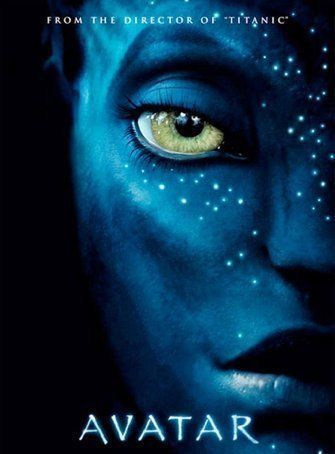
"I'd say that you were the perfect combination of imperfections. I'd say that your nose was just a little too short, your mouth just a little too wide. But yours was a face that a man could see in his dreams for the whole of his life."
-- Louis Mazzini (Dennis Price), in Kind Hearts and Coronets
James Cameron's Avatar isn't a great movie. The script (which Cameron wrote) is filled with thudding one-liners, a predictable romance, and a silly plot ripped from the pages of Ferngully; the score, by longtime Cameron collaborator James Horner, is similarly unmemorable. Yet its images are so arresting, so transcendent, that it stays with the viewer far longer than many better-made movies. And even the ham-fistedness of the message is part of its charm: few writer-directors other than Peter Jackson get the chance to make a $250 million movie. James Cameron got to see his vision through to the end, and whatever the flaws, that personal vision is part of what makes the movie so arresting.
The plot is simple: humans have come to a planet called Pandora in search of a rare, expensive metal called Unobtainium. (Seriously). Pandora is inhabited by 10-foot tall blue humanoid creatures called Na'vi, and a bunch of other nasty-looking creatures with sharp teeth and bad attitudes. The humans' plan? Clone a bunch of Na'vi and cross them with human DNA so that the clones can be controlled by human handlers with matching DNA, then infiltrate the Navi society and convince them to deliver the loot. When, inevitably, the humans decide to make war, the main human protagonist sides with the Na'vi, and re-enacts the classic movie plot of a Western outsider protecting the technology-deprived natives from an outside threat.
Cameron has long been obsessed with the ocean. His movie The Abyss (rating: 66) explored the ocean floor and the strange fluorescent beings that inhabited it, territory he revisited in his documentaries Expedition: Bismarck and Ghosts of the Abyss -- oh, and a little movie he made called Titanic (rating: 74). Avatar is set on a planet called Pandora where the humanoid beings are blue, the plants are huge and everything is splashed with day-glo color, and at night the plants and animals alike glow with an eerie luminescence. The movie is about a man who learns to control one of these humanoids with his mind, and lives part of his life as a native Na'vi; just as he begins to lose the ability to distinguish between which state is more real, Cameron's visuals blur the distinction between above water and below it.
The movie is mostly CGI, both in the backgrounds and for the Na'vi characters, and is as big a leap forward in visual effects as was Lord of the Rings (rating: 90) several years ago. (Avatar and LoTR shared the same effects house, the New Zealand-based Weta -- co-founded by Peter Jackson). Though no CGI movie has yet created a believable human character, the Na'vi are close -- being 10 feet tall and blue is a good way to transcend the Uncanny Valley. (The Uncanny Valley is the term for the effect where viewers find it harder to empathize with an artificial human image that looks close to -- but not exactly -- a real human face.) They're a natural progression from Gollum, who was a believable three-dimensional character whose ability to emote equaled that of any human actor in the Rings trilogy. The Na'vi take it one step further: the love interest in the movie, Neytiri, is hot.
One word about the 3D -- I saw the movie in 3D on Friday, then in regular 2D tonight. To my eyes, it's better in 2D. This is a basic complaint with the way that Real 3D works in theaters -- they give you the special glasses, which darken the image on the screen and simply make the images appear as flat layers on top of one another. The 3D effect actually counteracts the brain's natural tendency to process 2D images as representing a 3D world -- the flat layers actually look less real to me.
The acting is uneven. Sam Worthington, who plays protagonist Jake Sully, is a relative acting newcomer. His only previous major role was in Terminator: Salvation (rating: 70), where he played a similar character: a newcomer who wins the trust of others but then turns out to be an unwitting party in their betrayal. And he does it with a similarly blank affect and uncertain accent. This is a role that Mel Gibson would have nailed 15 years ago. In the pantheon of Australian stars, Worthington is somewhere beneath Simon Baker. Sigourney Weaver and Giovanni Ribisi do a good job with their supporting hero and supporting villain roles, and bad guy Stephen Lang chews scenery appropriately.
In 15 years, the movie's visuals will be commonplace rather than extraordinary, and what will be left is a fairly silly story and James Cameron's personal vision. It will no longer seem revolutionary. But it will always be sweet, and gorgeous, and fun -- just like every James Cameron movie, from Terminator to True Lies. The man has a heart of gold and an unbeatable track record.
Rating: 75
Crossposted on Remingtonstein.